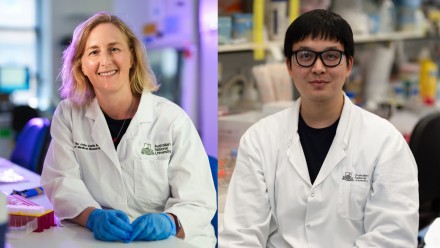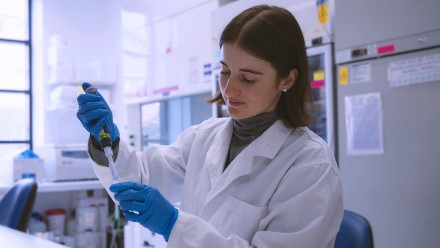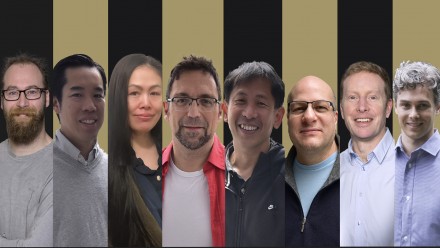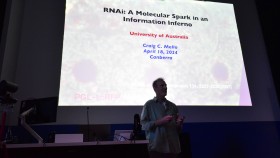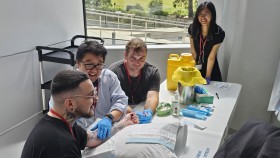You have three minutes—what’s your PhD on?
What does it mean to be a PhD?
Computer scientist and biologist Matt Might tackled this question with an illustrated guide.
In his take on this, PhD is essentially about creating a tiny little dent in the boundary of human knowledge:

The Illustrated Guide to a Ph.D., created by Matt Might (http://matt.might.net/articles/phd-school-in-pictures/; 2012). CC BY-NC 2.5
While the moral of the Matt Model is to remind PhDs to “keep pushing” the boundary, the illustration also helps explain why it can be so hard for many PhD scholars to communicate what they do to an audience outside their field:

The focus of academics and their audience can also be vastly different.
Lost in translation
Second-year PhD student Jennifer Hung can’t be more familiar with this feeling.
“I was fed up with not having the right words to answer the question ‘what is your PhD on?’ when asked by friends, family, and new acquaintances,” said Jennifer Hung, who focuses her study on RNA biology.
“I look at a key biological process called mRNA translation, which is how our cells make proteins from mRNA.” She wants to determine whether the shape of an mRNA molecule affects how efficiently it leads to the production of a protein.
Currently, Jennifer is working on a theory called the “closed-loop model of mRNA translation”, a model developed to explain how proteins are made in our cells.
“The more we understand how this process works, the more effectively we can design future RNA medicines.”
However, the abstract nature of Jennifer’s project left her unsure of how to convey the significance of her research.
First-year PhD student Sasanan Trakansuebkul shared the same concern.
Like Jennifer, Sasanan pursues a deeper understanding of RNA biology and how people can harness it to cure or treat diseases. Over the past few years, she has been pleased to see the development and use of the RNA COVID vaccine bolstering RNA biology as the next “big thing”.
But the rise of public awareness of RNA is one thing, whereas bringing the public into the work at the edge of the field is another.
“I’m looking at RNA surveillance, and we’re focusing on cryptic unstable transcript...”—Already a bit of a mouthful there.
Is there a quick and accessible way to explain their scientific endeavour to a non-expert, despite the seemingly inevitable encounter with abstruse concepts, theories, and technologies?
To find the answer, both young scientists took on a journey beyond their comfort zone: Jennifer signed herself up for The ANU Three Minute Thesis (3MT) competition, whereas Sasanan competed in the 3MT competition at the Canberra Health Annual Research Meeting (CHARM).
Bringing back the big picture
The 3MT is a competition where candidates present what their research is and why it matters in three minutes. With visual support from only one slide, how well the presenter engages the audience depends largely on what and how they present.
“The biggest challenge was probably the writing part,” said Sasanan, “It’s about trying to find the balance—giving the audience enough information, but not too much that it overwhelms them.”
One draft after another, Sasanan gradually realised the value of ‘zooming out’. Bit by bit, she brought the bigger picture back to her presentation—just like what Matt did to remind his PhD students of the big circle.
Eventually, she came up with a set of imagery that connects the niche of her research with the macro ‘real world’—cookbook, ingredients, and ice cream:
After “too many” iterations of her drafts, this is the final product of Sasanan’s presentation. Credit: ACT Health
For Jennifer, creativity kicked in a surprising way.
“When I begrudgingly watched an episode of the Formula One show ‘Drive to Survive’ on Netflix, I got so bored that I started daydreaming,” recalled Jennifer.
Lap after lap, the racetrack and the F1 cars turned into loops of mRNA molecules and protein-making machinery known as the ribosome in Jennifer’s mind.
When the daydream crept into reality, she wrote down the title of her talk: The hidden Grand Prix inside your cells.
By threading this simple analogy through the whole presentation, she linked something familiar in life with an intangible concept in biology.
“If the track is linear, after every lap, the race car has to turn around and go back to the start. But when the track is a circular loop, you can go round and round really fast.”
“Just like a formula one car on a track, when a piece of RNA brings together its beginning and end by looping back on itself, ribosomes can make proteins from them much faster...” she presented with confidence.

Jennifer presenting at the College 3MT Finals. Image: Yoshika Janapala
Keep pushing
As you may have guessed, both Sasanan and Jennifer won their competition.
Sasanan won the Canberra Hospital Foundation Award for the 3 Minute Thesis Winner.
When asked for take-home advice, Sasanan again referred to the bigger picture: “Don’t be afraid, and don’t feel bad to keep it very basic.”
“Your supervisor might not like your script because you’re not talking much about your project,” she laughed and said, “But remember, it’s about making everyone understand.”
On the other hand, Jennifer drove on to the next lap of her science communication journey by winning both the First Prize and the People’s Choice Award at the College of Health and Medicine 3MT Finals.
“I guess something good came out of having to watch the show after all,” Jennifer chuckled. This upcoming Thursday, she will be competing with other finalists for a chance to present at the Asia-Pacific 3MT Final.
“I still get nervous on stage, so I’m looking forward to receiving coaching on some public speaking techniques,” said Jennifer, “Regardless of the outcome of the ANU 3MT final, I’m grateful for the opportunity to challenge myself with an even bigger audience.”
Without a doubt, new experiences at their PhD boundaries are about to bud. May they keep pushing ahead.
-------------------
Update:
Jennifer Hung has won the 2022 ANU Three Minute Thesis (3MT) Final and will represent ANU to compete in the Asia-Pacific 3MT Final. Watch the ANU Final here:





